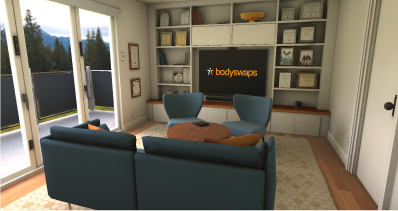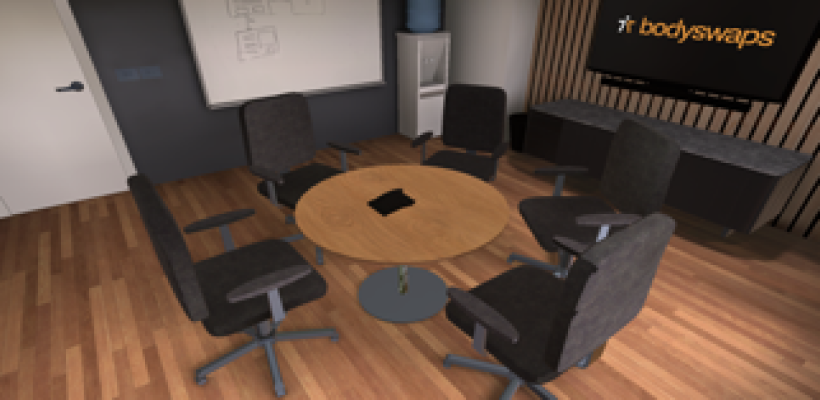Landing the Perfect Job, On Your Own Terms: Job Interview Skills
Tutor Notes
About this resource
Key learner outcome and goals
Learning Outcome
Craft relevant, memorable, and succinct answers to character-based questions
Learning Goals
- Identify your needs
- Showcase your strengths
- Craft convincing, compelling answers
- Communicate clearly
A word about terminology
As a medium, Virtual Reality is not best suited to didactic teaching methods.
However, our intention is that all Bodyswaps modules follow a student-centred constructivist pedagogy. This means creating rich experiences in which learners can explore key concepts and ideas and reach their own conclusions.
This is why our documents speak in terms of learning goals and outcomes, rather than measurable ‘learning objectives’ (a la Bloom’s Taxonomy) per se.
Content overview
The complete journey takes the learner through 4 interactive topics, led by virtual coaches Ashley and Abeeku, as well as ancillary activities such as onboarding, self-reflection, and the exit survey.
It is a linear experience, meaning the learner will be guided step by step through all the activities by the coaches.
We recommend that learners fully interact with each activity to get the full benefit.
It is estimated that each topic will take the learner approximately 5-10 minutes to complete, although completion times vary depending on whether the learner chooses to repeat topics to explore different options (encouraged) or to fine-tune their freeform responses.
Learner Journey
.svg)
.svg)
.svg)
.svg)
.svg)
.svg)
.svg)
.svg)
.svg)
Characters
Virtual mentor
.webp?width=720&height=1050&name=abeeku%20(1).webp)

Ashley
Virtual coachLearning Environments

Tutor Room - Bodyswaps HQ
Breakout Room

Meeting room
Identify your strengths
Spend a few minutes thinking about what you’re good at, what people compliment you on, and what you want people to remember about you.
Make a note of all the strengths you can think of that relate to your:
Discipline - skills that you’ve acquired through education and experience, such as computer skills, languages, study areas, job-specific skills and so on.
Aptitude - transferable skills like communication and people skills, analytical thinking, problem solving or organisation.
Personality - qualities that best describe you (e.g. enthusiastic, flexible, warm, dependable, conscientious, etc.)
Purpose
Familiarise learners with the controls and navigation
Location
Characters
Ashley and Abeeku (virtual coaches)
Duration
3:00
A generic onboarding sequence is provided as standard with virtual coaches Abeeku and Ashley.
The first time learners use Bodyswaps, this onboarding sequence familiarises them with the features of the app, takes them through an avatar selection and embodiment activity, and prepares them for the experience to come.
In the onboarding, learners will:
- Find out how this training is different from the rest
- Select their avatar
- Discover their virtual journal
- Learn how to navigate and use the tools and settings
Purpose
Introduce the module and reflect on current confidence levels before beginning the activities
Location
Characters
Journal
Duration
To begin the module, virtual coaches Ashley and Abeeku briefly discuss the power of tuning into what you personally want from a job, as well as knowing how to craft answers that connects your best qualities to the role.
They set out the learner’s goals for the module, and introduce the different activities they’ll be guiding the learner through in the module.
Then, they invite the learner to complete a short likert-style self-reflection survey, to indicate how confident they feel about the following key learning points:
- Identifying your needs
- Showcasing your strengths
- Crafting convincing, compelling answers
- Communicating clearly
These self-reflection questions will be repeated in the debrief at the end, to assess how the learner’s confidence levels have changed.
Note: If you wish to receive data about how the learner’s confidence levels have changed as a consequence of the training, It is important that they complete this introduction and the debrief at the end.
Purpose
Prime learners for the ‘best fit’ approach
Location
Hangout area
Characters
Ashley and Abeeku
Journal
Duration
In this activity, Ashley and Abeeku start off by asking the learner to tell them what they think is the best strategy going into an interview.
It’s easy to think it’s something like practicing answering as many questions as you can beforehand, or saying whatever the interviewer wants to hear in order to get the job.
But actually, they explain that an effective way to show you’re the best fit for the role is by telling the interviewer what you want.
Ashley proceeds to share a story about how she landed a job in her first big interview with a company that she always wanted to work for because she told them exactly what they wanted to hear. But six months down the line, she left – the bits of the job she loved were only a small part of her responsibilities, and all the things she bigged up were a nightmare for her.
As Ashley's story shows, getting the role that’s right for you means being true to who you are. Otherwise, you may set yourself up for disappointment. This gears up the learner for the next activity, where they’ll explore what it is they want and need from a job.
Purpose
Help the learner identify their non-negotiables
Location
Hangout area
Characters
Ashley and Abeeku
Duration
In order to land a job that’s right for you, you firstly need to pinpoint your non-negotiables. These are the things that motivate you, give your life meaning, and influence the way you prefer to work.
To help the learner explore their non-negotiables, the coaches ask them four self-reflective questions about their preferences and personality:
- Are you an extrovert who likes working in teams and in busy places, or an introvert who prefers working independently in calm, quiet environments?
- Are you detail-oriented and like concrete things like people, data and machines, or do you prefer abstract, ‘big picture’ things like theories, ideas and possibilities?
- Are you a ‘thinker’ who wants to use their intelligence to rise to the top, or a ‘feeler’ who is drawn to work that helps others and reflects your values?
- Do you like structure, organization and an orderly environment? Or do you like freedom and flexibility – perhaps even a little bit of chaos?
Following this likert-style quiz, Ashley and Abeeku discuss what the learner’s answers may reveal about their non-negotiables, and encourage them to use this to think about their preferences and natural strengths.
Purpose
Give the learner an opportunity to identify their personal strengths
Location
Hangout room
Characters
Abeeku and Ashley
Journal
Duration
A valuable thing to remember about interviews is that talking about your strengths isn’t bragging – it’s a central part of the process!
In this freeform activity, the learner has an opportunity to get more comfortable with identifying and talking about their strengths.
The coaches firstly offer guidance on how to think about their strengths. For example, asking yourself what you’re good at, what people compliment you on, and what you want people to remember about you . Then, the learner speaks out loud about what they think their strengths are.
AI-enabled analytics pick up on what they said and reveal how many strengths they managed to share. The learner will also get a chance to see a list of strengths on the screen behind the coaches after giving their answer, for further inspiration going forward: words like ‘creative’, ‘passionate’, communicator, ‘organised’, ‘disciplined’, ‘careful’, ‘problem solver’, and more.
The coaches go on to explain that the more strengths you can think of, the more you’ll have to draw upon when you come to craft your interview answer.
Purpose
Demonstrate good interview technique for connecting best qualities to the purpose of the job and company
Location
Meeting room
Characters
Abeeku and Ashley
Duration
To convince prospective employers that you’re right for the job, you need to craft an answer that shows how your strengths and non-negotiables connect perfectly to it.
In this observation activity, the learner gets to see some of this in action. Ashley takes on the role of an interviewer for a supermarket, “Best Life Food Mart”, and Abeeku takes on the role of the candidate, to show how he would craft a convincing answer.
The learner’s goal is to spot when Abeeku connects his strengths and non-negotiables to the role and the company:
- Working in a team
- Having a varied role
- Customer-facing
- Ethical
- Commercial awareness
- Relevant experience
After Abeeku wraps up his answer, the learner receives feedback about the strengths and non-negotiables they picked up on. They can rewind to each moment in his answer if they wish, and Ashley gives further insight about how Abeeku effectively connected them.
The coaches then gear up the learner for the next activity: crafting an answer for themself.
Purpose
Practise crafting convincing and compelling answers
Location
Meeting room
Characters
Abeeku and Ashley
Journal
N/A
Duration
It’s now time for the learner to have their go at crafting their own compelling answer.
For this freeform activity, the learner chooses from two roles – a sales assistant or barista – and practises giving their interview answer for it using their own words. Their aim is to connect their non-negotiables and strengths with the purpose of the company and the role.
A description of their chosen role is shown on the screen behind Ashley and Abeeku, to help them craft their answer.
As the learner speaks, AI-enabled analytics pick up on various aspects of their response, including how well they used words to connect their attributes and the role, and non-verbal aspects of their delivery like hand gestures and eye contact.
After reflecting on their answer, they can re-record as many times as they like if they want to keep practising.
Purpose
Debrief the learner upon completion of the training and prompt self-reflection
Location
Tutor room
Characters
Abeeku and Ashley
Journal
Duration
1:00
Abeeku and Ashley congratulate the learner for completing their journey through this course, and provide some closing thoughts on the power of advocating for what you need in an interview, and connecting these to the qualities you know the company needs.
Now, they’re invited to take the same likert-style survey from the beginning, to encourage the learner to reflect and self-report on their confidence levels following completion of the training.
The questions relate to how confident they now feel about the key learning points:
- Identifying your needs
- Showcasing your strengths
- Crafting convincing, compelling answers
- Communicating clearly
Purpose
Assess the effectiveness of the training itself
Location
Characters
Journal
Duration
Before the learner leaves the module, they are asked to complete a short survey about their experience.
This survey is not compulsory, but the data helps us to assess the effectiveness of our product and identify any areas that need improvement. Clients also find it beneficial when assessing ROI.
They are asked to mark whether they agree or disagree with the following statements, on a 10 point scale:
- I would recommend this experience to others
- The experience helped me identify elements I could improve upon
- I now have a better understanding of how to manage interview anxiety.
Explore your non-negotiables
In this module, we started to explore your non-negotiables with a simple diagnostic activity. If you’d like to know more about the personal characteristics that influence your priorities in life, you might like to try one of the free online profiling tools available.
Our top 5 recommendations are:
- 16 Personalities
- Big Five Personality test
- The PATH Assessment
- DISC personality test
- Holland Code (RIASEC) Test
Remember - these tests are a useful way to reflect on your attitudes and priorities, but they’re not hard science. If their assessment rings true, great! If not, take what feels right and leave the rest behind.
